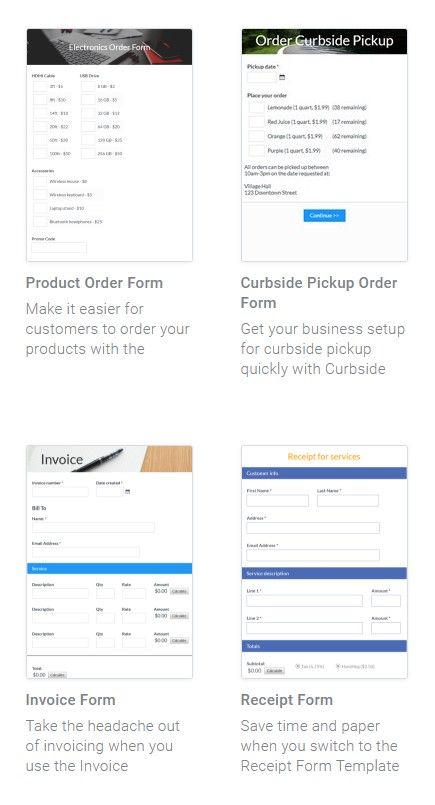Create Invoice Forms for Easy Custom Billing

Invoice forms give form owners the ability to track and tally totals for billing purposes. Whether for products or time keeping, invoices show charges, discounts, and payment details. Formsite’s order form templates and tools give form owners ways to create custom invoice forms, collect payments, and more.
Essential elements of invoices include:
- Invoice number and date issued
- Description of products or services
- Price and quantity for products or services
- Contact information and payment instructions
- Subtotal, discounts, taxes, and any other amount modifications
- Total due, date due, and terms
How to Make Invoice Forms
Use Formsite’s templates to start with an example invoice form or start with a blank form and add items as needed. The templates show example questions and styles to get the ball rolling.
The beginning of the form contains customer information using Short Answer and Email Address items. In some cases, the Long Answer item may give an easier way to collect customer contact information. For dynamically-generated invoices in embedded sites, use the Embed Code’s prePopulate parameter to pass information to Hidden Field items. Then use the pipe codes to insert the information to Description Text items.
We can consider an invoice a record of an order, so order form items make up the core of the invoice. Quantities and costs use the Text Field Quantity items followed by Text Field Pricing items for automatic totals. For more simple orders with standard fees, the Quantity List item can collect quantity numbers in a list of fees.
For displaying line totals or subtotals, use Calculation items with custom equations. If there are any taxes or other fees, use a percent item or coupon code item to adjust the order total. Taxes based on location can use a Dropdown Pricing item as the ‘state’ or ‘country’ selection item. Also, Rules can show follow-up or conditional items, like optional warranties or shipping insurance.
Sending Invoice Forms
The invoice form gets completed by the product owner or service provider, then the generated invoice goes to the customer. Sending the invoice document works best with Formsite’s Results Docs features.
The invoice data gets formatted as a PDF or Word document, then sent as an email attachment to the customer. An optional feature can save a copy of the invoice to a cloud storage service like Google Drive.
To support paying online, a Workflow link can send with the email and pass the invoice data to a payment form. Alternatively, use the Pre-populate link in place of the Workflow link to pass data to other forms. The destination form for both methods would use a payment integration to collect and track payments.
Pro Tip: Order History
Use a Results Filter for every customer, then create a Results Report with the filter. Send the link to the report in every email to allow the customer to see their real-time invoice history.
